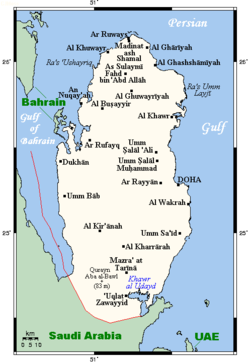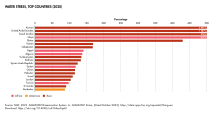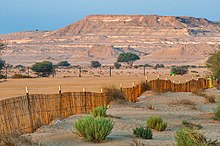Geography of Qatar
 | |
| Continent | Asia |
|---|---|
| Region | Middle East |
| Coordinates | 25°18′N 51°09′E / 25.30°N 51.15°E |
| Area | Ranked 164th |
| • Total | 11,571 km2 (4,468 sq mi) |
| • Land | 100% |
| • Water | 0% |
| Coastline | 563 km (350 mi) |
| Borders | Saudi Arabia: 60 km (37 mi) |
| Highest point | Qurayn Abu al Bawl, 103 m (338 ft) |
| Lowest point | Persian Gulf, 0 m (0 ft) |
| Climate | arid; mild, pleasant winters; very hot, humid summers |
| Terrain | mostly flat and barren desert covered with loose sand and gravel |
| Natural resources | petroleum, natural gas, fish |
| Natural hazards | haze, dust storms, sandstorms common |
| Environmental issues | limited natural freshwater resources are increasing dependence on large-scale desalination facilities |
| Exclusive economic zone | 31,590 km2 (12,197 sq mi) |

Qatar is a
Varying in width between 55 and 90 km (34 and 56 mi), the land is mainly flat (the highest point is 103 m (338 ft)) and rocky.[1] Notable features include coastal salt pans, elevated limestone formations (the Dukhan anticline) along the west coast under which lies the Dukhan oil field, and massive sand dunes surrounding Khawr al Udayd, an inlet of the Persian Gulf in the southeast known to local English speakers as the Inland Sea.[1]
General topography
The peninsula of Qatar is low-lying. Its shape is the surface expression of the Qatar Arch, one of the largest structural characteristics of the Arabian Plate.[2] It is enveloped by loose sand and pebbles broken off the outcropping limestone. Smooth plains are found in the east, where the surface is covered by fine-grained dust. The south and south-west portion of the peninsula mainly comprises sand dunes and salt flats.[3] Hill ranges (called 'jebels') can be found in western Qatar near the Dukhan area and at Jebel Fuwayrit on the northeast coast.[4] Jebel Nakhsh is a notable mountain ridge south of Dukhan and contains substantial deposits of gypsum.[5]
The coastline, which is roughly 700km²,
A sabkha (salt-flat) ecosystem known as the Dukhan Sabkha is found in the northern section of the Dukhan region in western Qatar. This sabkha, considered the largest inland sabkha in the Persian Gulf, runs for approximately 20 km, occupies an area of 73 km2, has a width of 2 to 4 km and a depth of between 6 and 7 meters.[7] It also accommodates the lowest point of Qatar, at six meters below sea level.[6] Studies suggest that the sabkha is fed by seawater from the Bay of Zekreet, north by approximately 3 km.[8]
Climate
The long summer (June through September) is characterized by intense heat and alternating dryness and humidity, with temperatures exceeding 40 °C (104 °F).[1] Temperatures are moderate from November to March,[1] ranging from as high as 39 °C (102 °F) in April to as low as 7 °C (45 °F) in January.[9] Rainfall averages 100 mm (3.9 in) per year, confined to the winter months, and falling in brief storms which are occasionally heavy enough to flood the small ravines and the usually dry wadis.[1]
Sudden, violent dust storms occasionally descend on the peninsula, blotting out the sun, causing wind damage, and temporarily disrupting transport and other services.[1]
The scarcity of rainfall and the limited underground water, most of which has such a high mineral content that it is unsuitable for drinking or irrigation, severely restricted the population and the extent of agricultural and industrial development the country could support until desalination projects began.[1] Although water continues to be provided from underground sources, most is obtained by desalination of seawater.[1]
| Climate data for Doha (1962–2013, extremes 1962–2013) | |||||||||||||
|---|---|---|---|---|---|---|---|---|---|---|---|---|---|
| Month | Jan | Feb | Mar | Apr | May | Jun | Jul | Aug | Sep | Oct | Nov | Dec | Year |
| Record high °C (°F) | 32.4 (90.3) |
36.5 (97.7) |
41.5 (106.7) |
46.0 (114.8) |
47.7 (117.9) |
49.1 (120.4) |
50.4 (122.7) |
48.6 (119.5) |
46.2 (115.2) |
43.4 (110.1) |
38.0 (100.4) |
32.7 (90.9) |
50.4 (122.7) |
| Mean daily maximum °C (°F) | 22.0 (71.6) |
23.4 (74.1) |
27.3 (81.1) |
32.5 (90.5) |
38.8 (101.8) |
41.6 (106.9) |
41.9 (107.4) |
40.9 (105.6) |
38.9 (102.0) |
35.4 (95.7) |
29.6 (85.3) |
24.4 (75.9) |
33.1 (91.5) |
| Daily mean °C (°F) | 17.8 (64.0) |
18.9 (66.0) |
22.3 (72.1) |
27.1 (80.8) |
32.5 (90.5) |
35.1 (95.2) |
36.1 (97.0) |
35.5 (95.9) |
33.3 (91.9) |
30.0 (86.0) |
25.0 (77.0) |
20.0 (68.0) |
27.8 (82.0) |
| Mean daily minimum °C (°F) | 13.5 (56.3) |
14.4 (57.9) |
17.3 (63.1) |
21.4 (70.5) |
26.1 (79.0) |
28.5 (83.3) |
30.2 (86.4) |
30.0 (86.0) |
27.7 (81.9) |
24.6 (76.3) |
20.4 (68.7) |
15.6 (60.1) |
22.5 (72.5) |
| Record low °C (°F) | 3.8 (38.8) |
1.5 (34.7) |
8.2 (46.8) |
10.5 (50.9) |
15.2 (59.4) |
21.0 (69.8) |
23.5 (74.3) |
22.4 (72.3) |
20.3 (68.5) |
16.6 (61.9) |
11.8 (53.2) |
6.4 (43.5) |
1.5 (34.7) |
| Average precipitation mm (inches) | 13.2 (0.52) |
17.1 (0.67) |
16.1 (0.63) |
8.7 (0.34) |
3.6 (0.14) |
0.0 (0.0) |
0.0 (0.0) |
0.0 (0.0) |
0.0 (0.0) |
1.1 (0.04) |
3.3 (0.13) |
12.1 (0.48) |
75.2 (2.95) |
| Average precipitation days (≥ 1.0 mm) | 1.7 | 2.1 | 1.8 | 1.4 | 0.2 | 0.0 | 0.0 | 0.0 | 0.0 | 0.1 | 0.2 | 1.3 | 8.8 |
| Average relative humidity (%)
|
74 | 70 | 63 | 53 | 44 | 41 | 50 | 58 | 62 | 63 | 66 | 74 | 60 |
| Mean monthly sunshine hours | 244.9 | 224.0 | 241.8 | 273.0 | 325.5 | 342.0 | 325.5 | 328.6 | 306.0 | 303.8 | 276.0 | 241.8 | 3,432.9 |
| Mean daily sunshine hours | 7.9 | 8.0 | 7.8 | 9.1 | 10.5 | 11.4 | 10.5 | 10.6 | 10.2 | 9.8 | 9.2 | 7.8 | 9.4 |
| Source 1: NOAA[10] | |||||||||||||
| Source 2: Qatar Meteorological Department (Climate Normals 1962–2013)[11][12] | |||||||||||||
| Sea Climate Data For Doha | |||||||||||||
|---|---|---|---|---|---|---|---|---|---|---|---|---|---|
| Month | Jan | Feb | Mar | Apr | May | Jun | Jul | Aug | Sep | Oct | Nov | Dec | Year |
| Average sea temperature °C (°F) | 21.0 (69.8) |
19.4 (66.9) |
20.9 (69.6) |
23.3 (73.9) |
27.8 (82) |
30.5 (86.9) |
32.4 (90.3) |
33.6 (92.5) |
32.8 (91) |
30.8 (87.4) |
27.5 (81.5) |
23.5 (74.3) |
26.9 (80.5) |
| Source:[13] | |||||||||||||
Wildlife
Flora
Although most of the country consists of
In the south, where groundwater is exceedingly scarce, vegetation can found growing in wadis (dry river valleys) fed by run-off from nearby hills and in rawdas.[16]
Fauna

There are 21 species of mammals that have been recorded in Qatar.[17] Larger terrestrial mammals such as the Arabian oryx and Arabian gazelle are protected animals and are held in nature reserves.[18] The Arabian gazelle is the only native gazelle species to Qatar and is locally referred to as 'rheem'.[19]
Qatar's territorial waters in the
Area and land boundaries

Qatar has one land border. The country borders Saudi Arabia to the south. The boundary with Saudi Arabia was settled in 1965 but never demarcated.[1] Qatar's northwest coast is fewer than 30 km (19 mi) from the main islands of Bahrain,[1] while the small Hawar Islands of Bahrain are only 1.4 km (0.8 mi) off that coast.[citation needed] The peninsula's northernmost point is Ras Rakan.[22]
Maritime claims
contiguous zone:
24 nmi (44.4 km; 27.6 mi)
exclusive economic zone:
31,590 km2 (12,197 sq mi) as determined by bilateral agreements, or the median line
territorial sea:
12 nmi (22.2 km; 13.8 mi)
Islands
Of the islands belonging to Qatar, Halul is the most important.[1] Lying about 90 km (56 mi) east of Doha, it serves as a storage area and loading terminal for oil from the surrounding offshore fields.[1] Hawar and the adjacent islands immediately off the west coast are the subject of a territorial dispute between Qatar and Bahrain.[1]
Resources and land use

Based on estimates in 2011 estimates, 5.6% of the land is agricultural. Arable land comprises 1.1%, permanent crops 0.2% and permanent pasture 4.6%. 94.4% of the land was used for other uses.[23] In 2003, 129.4 km2 (50.0 sq mi) of land was irrigated.[23]
Geology and mineral deposits


| Era[24][25] | Period | Formation | Member | Mineral deposits and resources |
|---|---|---|---|---|
| Paleozoic | Cambrian | Hormuz Formation | Dolomite, sandstone | Hematite, carbonates, asbestos |
| Permian Carboniferous |
Khuff Formation | Petroleum | ||
| Mesozoic | Jurassic | Uwainat Limestone Formation, Arab Formation | Dolomite, limestone, evaporite, shale | Petroleum |
| Cretaceous | Shuaiba Formation | Marlstone, limestone, shale | Petroleum | |
| Cenozoic | Paleocene | Umm Er Radhuma Formation | ||
| Lower Eocene | Rus Formation | Chalk | Celestine, gypsum | |
| Lower Dammam Formation | Dukhan limestone, Midra shale, Rudjm Aid limestone | Palygorskite, pyrite | ||
| Middle Eocene | Upper Dammam Formation | Umm Bab chalk, Simaisma dolomites | Dolomite, limestone | |
| Miocene | Upper and Lower Dam Formation | Clay, limestone, gypsum | Clay, limestone, celestine | |
| Pliocene | Hofuf Formation | Sandy clay, sandstone | Sand, gravel | |
| Pleistocene | Miliolite limestone | Limestone | ||
Most of Qatar's surface lies on Cenozoic strata. These strata have an abundance of mineral resources, most of which have not yet been exploited, such as limestone and clay.[26] The Upper Dammam Formation in the Middle Eocene period is the most predominant surface layer. It is constituted by limestone and Dolomite.[27] The northern zone of Qatar, which comprises the most significant source of fresh groundwater in the peninsula, primarily draws its water from the Umm Err Radhuma Formation and Rus Formation dating to the Paleocene and Lower Eocene periods, respectively.[28] The Mesozoic strata are the most important layers as they contain petroleum. The first substantial deposit of crude oil was discovered in 1940 in the Jurassic period Arab Formation.[29]
Political and human geography

The capital,
Doha is the capital of the country and the major administrative, commercial, and population center.[1] In 1993 it was linked to other towns and development sites by a system of about 1,000 km (620 mi) of paved roads.[1] Doha's international airport has an approximately 4,500 m (14,800 ft) main runway, capable of receiving all kinds of aircraft.[1]
Historically, settlement distribution in Qatar has mainly been dictated by the presence of obtainable fresh groundwater.[14] Rawdas, which are depressions with shallow groundwater, have typically been the most popular sites of settlement throughout the peninsula.[15] In Qatar's south, where groundwater is exceedingly difficult to obtain, settlement formation was mostly limited to wadis (dry river valleys) fed by run-off from nearby hills and rawdas.[14]
Environmental agreements
Qatar is currently party to the following international environmental agreements:[23]
- Biodiversity
- Climate Change
- Desertification
- Hazardous Wastes
- Law of the Sea
- Ozone Layer Protection
References
- ^ .
- . Retrieved 17 July 2015.
- ^ ISBN 978-81-85492-04-9.
- ^ "About Qatar". Ministry of Municipality and Environment. Retrieved 23 February 2019.
- ^ Jacques Leblanc (December 2015). "A Historical Account of the Stratigraphy of Qatar, Middle-East (1816 to 2015)". Academia. p. 73. Retrieved 23 February 2019.
- ^ a b c Sadiq, Abdulali M. (2003). "Geologic Evolution of the Dukhan salt flats in Western Qatar Peninsula, Arabian Gulf" (PDF). Qatar University Science Journal (23): 41–58. Retrieved 23 February 2019.
- S2CID 7262453. Retrieved 23 February 2019.
- ISBN 978-1-4020-5071-8.
- ^ Casey & Vine (1991), p. 69
- ^ "Doha International Airport Climate Normals 1962-1992". National Oceanic and Atmospheric Administration. Retrieved September 29, 2016.
- ^ "Climate Information For Doha". Qatar Meteorological Department. Archived from the original on November 27, 2016. Retrieved November 27, 2016.
- ^ "41170: Doha International Airport (Qatar)". ogimet.com. OGIMET. 19 March 2021. Retrieved 19 March 2021.
- ^ "Doha Sea Temperature". seatemperature.org. Retrieved 28 May 2022.
- ^ a b c Macumber, Phillip G. (2015). "Water Heritage in Qatar". Cultural Heritages of Water: Thematic Study on The Cultural Heritages of Water in the Middle East and Maghreb. UNESCO World Heritage Convention. academia.edu. UNESCO. p. 223. Retrieved 21 February 2019.
- ^ a b Macumber, Phillip G. (2015). "Water Heritage in Qatar". Cultural Heritages of Water: Thematic Study on The Cultural Heritages of Water in the Middle East and Maghreb. UNESCO World Heritage Convention. academia.edu. UNESCO. p. 226. Retrieved 21 February 2019.
- ^ Macumber, Phillip G. (2015). "Water Heritage in Qatar". Cultural Heritages of Water: Thematic Study on The Cultural Heritages of Water in the Middle East and Maghreb. UNESCO World Heritage Convention. academia.edu. UNESCO. p. 227. Retrieved 21 February 2019.
- ^ "Mammals database". Qatar e-nature. Retrieved 21 February 2019.
- ISBN 978-0-907151-50-0.
- ^ "Arabian Goitered Gazelle (Reem)". Al Waabra Wildlife Preservation. Retrieved 21 February 2019.
- ^ Rees, Alan F.; Zogaris, Stamatis; Papathanasopoulou, Nancy; Vidalis, Aris; Alhafez, Ali (April 2013). "Qatar Turtle Management Project: Inception report". researchgate.net. Ministry of Environment (Qatar). Retrieved 21 February 2019.
- ISBN 978-1-78238-372-7.
- ISBN 978-1-4020-8638-0.
- ^ CIA.
- ^ Casey & Vine (1991), p. 73
- ^ Al-Kubaisi, Mohammed Ali M. (1984). Industrial development in Qatar: a geographical assessment (PDF). Durham E-Theses, Durham University. p. 12.
- ^ Al-Kubaisi, Mohammed Ali M. (1984). Industrial development in Qatar: a geographical assessment (PDF). Durham E-Theses, Durham University. pp. 10–11.
- . Retrieved 27 July 2015.
- ^ "Umm er Radhuma-Dammam Aquifer System (Centre)". Inventory of Shared Water Resources in Western Asia. Retrieved 27 July 2015.
- ^ Al-Kubaisi, Mohammed Ali M. (1984). Industrial development in Qatar: a geographical assessment (PDF). Durham E-Theses, Durham University. p. 11.
Bibliography
- Casey, Paula; Vine, Peter (1991). The heritage of Qatar (print ed.). Immel Publishing. ISBN 978-0-907151-50-0.
External links
- "East of Qatar". Terrestrial Ecoregions. World Wildlife Fund.
